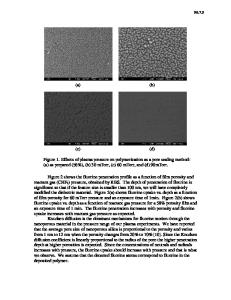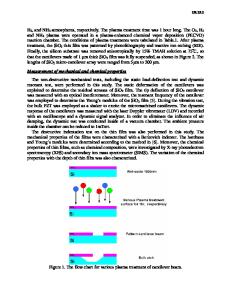Tuning the Mechanical Properties of Poly-silicon Film by Surface Modification Using Plasma Treatment
- PDF / 759,814 Bytes
- 6 Pages / 612 x 792 pts (letter) Page_size
- 6 Downloads / 293 Views
O8.9.1
Tuning the Mechanical Properties of Poly-silicon Film by Surface Modification Using Plasma Treatment Wang-Shen Su, Weileun Fang and Ming-Shih Tsai 1 Institute of Microelectromechanical Systems, National Tsing-Hua Uninersity No. 101, Sec. 2, Kuang-Fu Rd., Hsinchu 300, Taiwan 1 National Nano Device Laboratory, 1001-1 Ta-Hsueh Road, Hsinchu 300, Taiwan ABSTRACT The mechanical properties of thin film are very critical for the performance of MEMS devices. Since Poly-silicon film is of great use in MEMS, this study investigates the surface modification by various plasma treatments to finely tune the chemical and mechanical properties of poly-silicon film. Various plasma treatments, including H2, O2, and NH3, were implemented to modify the original Si-Si film bonding, Young’s modulus, and hardness of poly-silicon film. These were significant Si-O, Si-OH/Si-H and Si-NH2/Si-N bonds formed after O2, H2 and NH3 plasma treatment, respectively. According to the H analysis from SIMS depth profile of, the thickness of surface modified layer would be ranged from 50 to 120 nm. In summary, the surface modification with H2 plasma can reduce the elastic modulus of poly-silicon film for about 32.3%; moreover, the following vacuum annealing will further reduce the elastic modulus for about 60.2%. Therefore, surface modification with an adequate plasma treatment would be an effective method to change the chemical and mechanical properties of poly-silicon film. INTRODUCTION Thin films on semiconductor substrates are of special interest to academics and industries involved in microelectronic devices and micro-electro-mechanical systems (MEMS). The mechanical properties of thin film are very critical for the performance of MEMS devices. However, thin films have, in general, different mechanical properties from their bulk counterparts. In this regard, the mechanical properties of thin films have attracted lots of attentions [1]. Polycrystalline silicon film has been extensively employed in MEMS. It is important to control the mechanical as well as chemical properties of poly-silicon films, so as to improve the performance of the MEMS devices. It has been recognized that the surface morphology of the poly-silicon films has significant influence on the tribological characteristics of MEMS [2]. The rough surface can lead to serious adhesion, friction and wear problems in MEMS devices, and subsequently on contribution to failure [3,4]. Plasma treatment for surface cleaning and modifications is widely implemented in the advanced semiconductor manufacturing [5]. In short, it is important to exploit the characteristics of plasma treatment to change the bonding and structure of thin film surface. Thus, the surface morphology and mechanical properties of thin films can be tuned. In this study, various surface treatments using the O2, H2 and NH3 plasmas on the poly-silicon film were investigated. The changes of surface morphology, chemical bonding and mechanical properties of poly-silicon after plasma treatment were characterized by X-ray photo
Data Loading...










